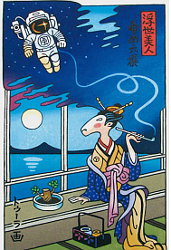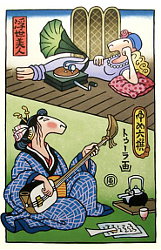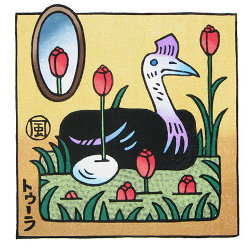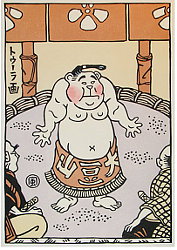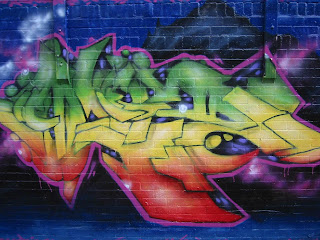Funny Art works by Tuula Moilanen
Tuula Moilanen - born 1959
Tuula Moilanen is a printmaker, book artist and freelance writer, born in Kuopio, Finland, in 1959, with a very special passion for the world of 'all things Japanese'. Her style is a kind of witty, modern ukiyo-e and not comparable to anything else you ever may have seen before. Since 1989 she has lived in Japan.
The images on this page are link-sensitive and take you to other articles or web sites in which you might be interested.
Affiliations
- Finnish Printmakers Association (STG).
- International Ukiyo-e Society, Japan.
- Kyoto Art Council, Japan.
Studies
- 1978-1981 - Kankaanpae School of Fine Art, Department of Printmaking (Finland).
- 1981 - 1989 - University of Jyvaeskylae. Faculty of the Humanities. (Finland). MA in Art education, studies in Art history and Philosophy.
- 1989-1991 - Kyoto Seika University. Department of Printmaking. (Japan). Research student in Japanese woodcut and papermaking under the guidance of professor Akira Kurosaki.
- 1992-1996 - Studies in papermaking, bookbinding and Japanese calligraphy under the supervision of Japanese masters in Kyoto and Osaka.
- 1996-1997 - Studies in paper conservation and bookbinding in Florence, Italy under the supervision of Italian masters.
- 2007-2010 - Research on the symbols of Time and Eternity in Japanese woodblock printmaking for PhD degree at the University of Art and Design Helsinki.
Exhibitions
- Solo and group exhibitions in Finland since 1980.
- Group exhibitions in Europe 1985-1988 / 2004-05.
- Solo and group exhibitions in Japan since 1990.
- Group exhibitions in America/Canada since 2000.
Teaching
- Teacher and lecturer of printmaking, papermaking and bookbinding in several art institutions in Finland since 1986, including courses in woodblock printmaking at the Finnish Art Academy.
- Teacher of drawing and painting at Dessanjuku drawing school, Kyoto, Japan 2000-2008.
- Lecturer of Aesthetics and Western art philosophy at Osaka Gakuin University 2001-2003.
- Part time lecturer at Kyoto Seika University, department of printmaking, Japan since 2009.
Main Publications
- 1995 - Kaesintehty paperi (Handmade paper). Taide Art Publisher, Finland.
- 1997 - Kirjansidonnan opas (Manual of bookbinding). Taide Art Publisher, Finland.
- 1999 - The Art and Craft of Woodblock printmaking (3 authors: Laitinen-Moilanen-Tanttu).
- Chapter of the Japanese woodcut techniques and its Western applications by Moilanen. UIAH Publications, Finland.
- 2001 - Haru Ichiban (Artist life in Kyoto) Sharda publisher, Finland.
- 2009 - Japaninmatkaajan Fraasikirja (Travelle's phrase guide to Japan). 3 authors: Moilanen-Komahara-Wai Lwin Moe. Translations and illustrations by Tuula. Atena publisher Finland.
Selected Public Collections
- Parliament House of Finland.
- Alvar Aalto Art Museum (Jyvaeskylae).
- Wainoe Aaltonen Art Museum (Turku).
- Mikkeli Art Museum.
- Kuopio city collection.
- Cultural board of Central Finland.
- Kuopio Children's Hospital.
- Jyvaeskylä Central Hospital.
- Lappeenranta Medical station.
- House of Humor and Satire, Gabrovo Bulgaria.
- Honen-in Temple, Kyoto Japan.
- Oni no Koryu Hakubutsukan Museum, Oe (Kyoto pref.) Japan.
Copyright ©2001-2011 artelino GmbH. All rights reserved








